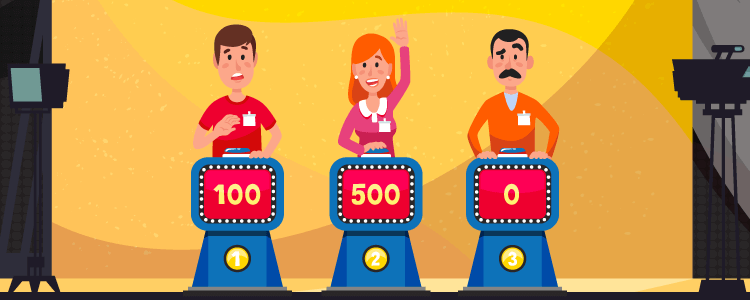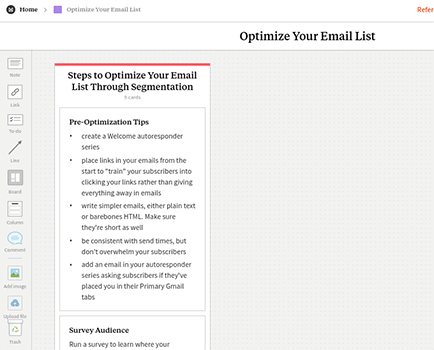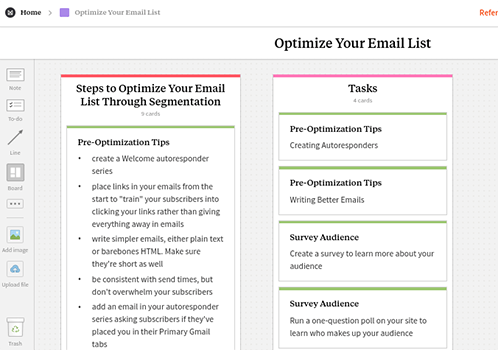How To Run A 30-Day Challenge To Engage Your Blog Readers

Do you struggle with keeping your audience active and engaged with your blog? Are you having trouble attracting new visitors on a consistent basis?
What you need is a way to awaken your existing audience while onboarding an abundance of new readers. That’s exactly what a 30-day challenge can do for your blog.
Challenges have a powerful affect on people. The pressure of a time limit combined with the motivation social interaction brings can truly light a fire underneath people.
In this post, we’re going to cover everything you need to know about running a 30-day challenge on your blog.
What can you achieve with a 30-day challenge?
The point of a challenge is to engage readers by encouraging active and dormant followers alike to restore their interest in your blog. However, running a challenge is one of the hardest and most demanding projects you can implement on your blog, so what benefits does “engaged readers” actually translate to?
Traffic is the biggest advantage you’ll experience, especially when you run challenges that last longer than seven days. Promotion must begin before your challenge even starts, and you’ll receive buzz across social media and other platforms throughout the challenge.
You’ll receive more social shares as a result, and the influx of traffic will lead to more email sign ups and sales for products related to your challenge.
As your challenge plays on, you’ll find yourself with a larger network as you cross promote blog posts, podcast episodes, products and followings with other influencers in your niche.
You may also find yourself more productive, especially if you’re taking part in the challenge alongside your audience.
Stage 1: Pick a challenge
There’s a lot of variety of in the world of 30-day challenges, and yes, there are enough of them to create their own world.
There’s the Inktober challenge where artists create one ink-based drawing or illustration for every day of October. There’s also NaNoWriMo, or National Novel Writing Month, where authors all around the world attempt to write 50,000-word manuscripts in the month of November.
Nathalie Lussier runs a 30-day list building challenge you can start at any time of the year. While the challenge doesn’t have a specific numeric goal, it is designed to help you earn more email subscribers over the course of a month.
There are also countless fitness challenges.
No matter how different these challenges are, one thing is certain: they all work toward solving specific problems members of their respective niches are having. Refer to Blogging Wizard’s guide on how to find your audience’s pain points to come up with a focus for your challenge.
Go through the guide to discover your audience’s biggest pain points. You should also consider the struggles you’re having or have had. Some bloggers create challenges to motivate themselves into achieving goals they’re struggling to reach.
Are there any goals you haven’t been meeting? Have you accomplished anything noteworthy? Jot them down.
Once you have a list of problems related to your niche, come up with solutions (written as brief summaries) for each of them. Think of the transformation you want your reader to have by the end of the challenge. Then, break those solutions down into the steps your reader will need to take to achieve them.
Cut your list down to pain points/solutions whose steps you feel you can stretch out over 30 days. Each step can take one day, two days, three days, etc. You don’t need to restrict yourself or your reader to one step per day.
It’s just a matter of choosing the challenge that excites you most after that.
Stage 2: Plan your 30-day challenge
The challenges I listed above vary, both in the types of goals they target as well as how they’re implemented.
Inktober wants you to create one piece of artwork per day while NaNoWriMo wants you to write 50,000 words between November 1 and November 30 with no strict guidelines on how many words you should write each day.
While these challenges may help you be more productive than you typically are, they’re not designed to guide you through the process. You don’t learn anything new nor do you discover tips, tricks and techniques you can carry with you long after the challenge ends.
It’s better to break your challenge, or rather your solution, down into tasks your reader can complete over the course of 30 days. That is the first pillar of a 30-day challenge.
Creating phases for your challenge
Consider the steps you wrote down for your solution earlier. Feel free to organize these steps into three phrases (where each phase lasts ~10 days). You don’t have to, but it can make planning easier on yourself.
Let’s use a blogging-related challenge as an example. Let’s say you have an email list for your blog, but it’s only a basic list and you have low open and click-through rates.
A great solution to this problem would be to segment your email list as a way to target the diverse sections within your audience and ensure your emails are only sent to the individuals who would be most interested in them.
So, here’s what I have so far:
- Problem – Reader has a decent-sized email list that’s growing steadily, but their subscribers are not opening their emails. The ones that do open their emails are not clicking the links within them.
- Solution – Create three to five segments that define subscribers based on their interests, their experience and the actions they take.
I’ve written down steps the reader should take to create a segmented email list with Milanote. You can just as easily use Coggle, Mindmeister, your preferred mind-mapping tool or a word processor.

Now, I can organize these steps into three phrases. On your end, use your mind-mapping tool to color code each step based on which phase it should fall under.
The phases in my example challenge use the following structures:
- Phase 1: Preparation – Tasks the reader should do before they create their segments to maximize their success as well as to determine what their segments should be.
- Phase 2: Development – Tasks the reader should perform to create segments in their email marketing service applications.
- Phase 3: Implementation – Tasks that fully implement the reader’s segments well enough to segment new and existing subscribers alike.

Planning tasks for your challenge
Next, break down your phases or steps (if you didn’t create phases) into tasks. Each task will represent one blog post or piece of content. They should each have a clear focus and be actionable enough for your reader to reach a new milestone toward the challenge’s primary objective.
So, I’ll break down my “Pre-Optimization Tips” step into two tasks based on the way the topics I want to cover in that step can be organized. One task will cover autoresponders while the other will feature tips on how to write better emails.

Go down your own list, and break each step down into actionable tasks.
Creating content for your challenge
The second pillar of a 30-day challenge is content, and it’s definitely what will take the longest to prepare out of this whole process. The first thing you need to do is determine the types of content you’d like to feature in your challenge, at least for the tasks.
You can work exclusively within the realms of your blog, create audio content in the form of podcast episodes, publish videos or use a combination of all three. Audio quality is extremely important for podcasts and video content, so be sure to skip this type of content for now if you don’t have the time to learn a new medium.
Next, go through each task one by one, and determine the best type of content to use for each. You can even create multiple types of content for each task to give readers the option of choosing formats most suitable to the ways they learn.
Just make sure you’re being realistic about how much content you’re willing or are able to produce in the timeframe you give yourself to prepare for your challenge.
The next part involves creating the content for your challenge once you determine which type you’d like to use for each task. This will likely eat up most of your time during the preparation process.
Lastly, use existing content where possible to reduce the amount you need to produce.
As a side note, you should come up with and create lead magnets for each post to maximize the number of email sign ups you receive throughout the challenge as well as to make things more interactive for your audience.
Stage 3: Implement your challenge
Once you’re done creating content for your challenge, it’s time to get to work on launching it. This involves the third and fourth pillars—promotion and distribution.
If you try to promote the challenge on social media, your blog and your email list after it launches, you’re only setting yourself up for failure. You need to generate buzz online and within your audience well before the challenge starts.
Doing this also gives you the chance to connect with other bloggers so you can cross promote and maximize your success.
Finally, the distribution stage is where you’ll actually launch the challenge.
Promotion
As I said, in order for your challenge to have as much success as possible, you must promote it inside and outside of your audience.
Here are a few ways you can promote it directly to the audience you’ve already built:
- Blog – Start teasing the challenge in your most recent blog posts, and dedicate an entire post announcing and explaining your challenge.
- Email List – Approach this in the same way by teasing the challenge in emails and dedicating one email to its announcement.
- Social Media – Create promotional images, and come up with a hashtag as you tease and announce the challenge to your following on various social media platforms.
- Podcast – Same as your blog, but you’ll tease the challenge in your most recent episodes instead, then release a shorter bonus episode dedicated to its announcement.
Here are ways you can promote your challenge outside of your audience:
- Network – Reach out to other influencers in your niche to see if they’d be willing to collaborate with you on this challenge, either by doing the challenge with you or offering discounts on products related to it. Offer discounts of your own as incentives to cross promote.
- Guest Post/Host – Think of this as a digital press tour, only you’ll be promoting your challenge instead of a book or product. Write guest posts related to your challenge and guest host on other podcasts, being sure to choose blogs and podcasts related to your niche to maximize your potential.
- Advertise – Buy ad space on Google, Facebook, Instagram and YouTube to reach a wider audience.
No matter how many of these promotion tactics you use, you must create a landing page with an opt-in form to collect new and existing subscribers interested in your challenge. You can even create a tag in your email marketing service application called “Interest: 30-Day Challenge.” This will allow you to send targeted content before and after the challenge.
Distribution
Once you launch the challenge, ensure there’s at least one day between each task/piece of content you distribute to your audience. Some of your readers lead busy lives, and you don’t want them falling behind as a result.
Fill in the gaps with updates on social media, YouTube, your email list and livestreams. You can even feature progress from your readers if you aren’t partaking in the challenge yourself.
In general, most of the tactics we talk about in our article on ‘how to promote your blog‘ can be used for your 30-day challenge.
Final thoughts
It’s hard to predict the fallout of a 30-day challenge. You’ll see a high amount of engagement before and throughout, but there’s no telling how long that will last once the challenge’s runtime is up.
When it comes to the content you publish afterward, it’s best to stick to topics loosely related to your challenge. For our challenge on optimizing your email list, we could publish reviews on various email marketing software tools, a tutorial on how to build a highly optimized landing page, case studies from subscribers and more.
The idea is to hold the attention of the audience you’ve built by publishing resourceful content that’ll help them even after the challenge is over.
Be sure to check out our guide on how to boost engagement on your blog if you need more help in this area.

